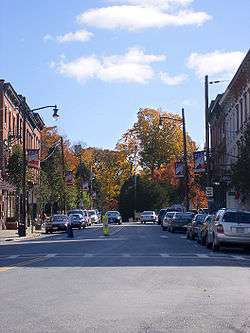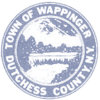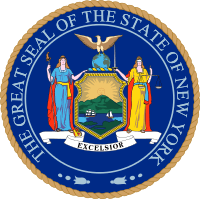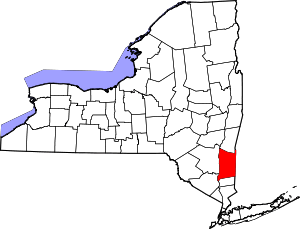Wappinger, New York
| Wappinger, New York | ||
|---|---|---|
| Town | ||
| Town of Wappinger | ||
|
Village of Wappingers Falls, downtown | ||
| ||
 Location of the Town of Wappinger, New York | ||
| Coordinates: 41°35′20″N 73°53′59″W / 41.58889°N 73.89972°W | ||
| Country | United States | |
| State | New York | |
| County | Dutchess | |
| Town of Wappinger | May 20, 1875 | |
| Government | ||
| • Type | Town Council | |
| • Town Supervisor | Lori A. Sucich Jiava (R) | |
| • Town Council |
Members' List
| |
| Area | ||
| • Total | 28.5 sq mi (73.9 km2) | |
| • Land | 27.1 sq mi (70.1 km2) | |
| • Water | 1.5 sq mi (3.8 km2) | |
| Elevation | 197 ft (60 m) | |
| Population (2010) | ||
| • Total | 27,048 | |
| • Density | 1,000/sq mi (386.0/km2) | |
| Time zone | Eastern (EST) (UTC-5) | |
| • Summer (DST) | EDT (UTC-4) | |
| ZIP code | 12590 | |
| Area code(s) | 845 | |
| FIPS code | 36-78157[1] | |
| GNIS feature ID | 0979595[2] | |
| Website |
www | |
Wappinger is a town in Dutchess County, New York, United States. It is in the Hudson Valley region, 70 miles (110 km) north of New York City, on the eastern bank of the Hudson River. The population was 27,048 at the 2010 census.[3] The name is derived from the Wappinger Indians who inhabited the area.
History
The Wappinger were a confederacy of Native Americans whose territory, in the 17th century, was spread along the eastern shore of the Hudson River. Primarily based in what is now Dutchess County, their territory bordered Manhattan Island to the south, the Mahican territory bounded by the Roeliff Jansen Kill to the north,[4] and extended east into parts of Connecticut.[5]
They spoke an eastern-Algonkian language. Culturally they were closely related to the Lenape people (Delaware Indians) to the west and south of Wappinger lands, and also related to the Mahican people to their immediate north and to the Metoac peoples of Long Island. Wappinger means "easterner" in most Algonkian languages.[6]
The town of Wappinger, originally a part of the town of Fishkill, was formed on May 20, 1875, and lies wholly within the limits of the historic Rombout Patent, granted in 1685. Among the first settlers were the VanBenschotens of New Hackensack.[7] The town of Wappinger was primarily agricultural, while mills lined the creek in the village of Wappingers Falls.
On the night of February 6, 1871, at the drawbridge in New Hamburg that crosses Wappinger Creek – where northbound trains pass from Wappinger into the town of Poughkeepsie – the Hudson River Pacific Express crashed into a passing freight train, which had broken an axle. There were 22 confirmed deaths, but while some bodies were taken to Poughkeepsie for identification, others were never recovered. On September 1, 1892, at the same location, a mail train on the Hudson River Railroad derailed. The draw had been opened to let the small steamer Young America pass through, and was being closed when the train came northward. A gap of several feet remained when the engine reached the draw. The engine jumped the gap, but the rear end of the tender dropped enough to stop the progress of the train; then, the mail car, crashing into the tender, pushed it against the locomotive. The engineer, fireman, and mail clerk were all killed.
Historic districts
- Wheeler Hill Historic District is located in the town of Wappinger. It includes 49 contributing buildings, 15 contributing sites, and four contributing structures. It encompasses the estates of Obercreek, Elmhurst, Edge Hill, the former estates of Henry Suydam and William Crosby, and Carnwath Farms that were developed between 1740 and 1940. Also included are two 18th century riverfront commercial structures, the Lent / Waldron Store, and Stone House at Farmer's Landing. Within this district, Wheeler Hill Road was once known as Rives Avenue or Hill, after Francis Rives who purchased the former Willis estate (Carnwath Farms) in 1870.[8]
- The Wappingers Falls Historic District is in the center of the village of Wappingers Falls, and was added to the National Register of Historic Places in 1984. It is roughly centered along South Avenue, West Main Street and Wappinger Creek. It includes Mesier Park and many adjacent residential neighborhoods, roughly bounded by Elm, Park, Walker, Market and McKinley streets. Much of the district was built in the wake of the industrialization of Wappingers Falls in the 19th century, and its styles represent a cross-section of that century. The two sides of the district are connected by an 1884 stone arch bridge that replaced earlier wooden structures.
Hamlets
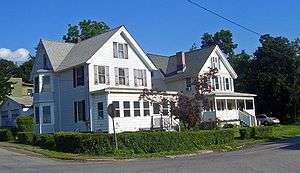
- Chelsea – A hamlet in the southeast part of the town near the Hudson River, formerly Low Point and later, Carthage Landing. The hamlet's post office was established in 1840 as Low Point. The current post office was the former 1875 district school.
- Diddell was a hamlet in the northeast part of the town, just south of New Hackensack. By the 1800s the Maybrook Railroad, which ran from Pawling to Poughkeepsie, established a station here.[9]
- Hughsonville – A hamlet situated one mile south of Wappingers Falls and derives its name from William Hughson, one of four brothers who emigrated from England. Dr. Walter Hughson was born in Hughsonville on October 31, 1816. He became a successful surgeon in the county and died of consumption on December 9, 1857.[10] The Presbyterian Church of Hughsonville was erected in 1840. A post office was established there in 1847.[11] The Hughsonville Fire Department traces the hamlet's establishment to 1912.
- Middlebush, situated about a mile south-east of Wappingers Falls, was an early business center. A post office was located there in 1824 that also served residents of Chelsea. The first Baptist church in the town was organized there in 1782. Abm. Van Wyck deeded the Society a piece of land for a site for a church and burying ground. The old cemetery remains, southeast of the intersection of Middlebush Road and Old Route 9. In 1830 that meeting house became the property of the Methodist church, and was used by them as a house of worship until the present Methodist church in Wappingers Falls was erected in 1869, when it was taken down and the material used in the construction of the barn and sheds connected with that church.[11] This hamlet has two schools, businesses, housing, and the town hall for the town of Wappinger.
- Myers Corners – at the intersection of Myers Corners Road and All Angels Hill Road was named after John Myers of Holland and was mostly farm land but had a doctor, a school and a tavern.[11]
- New Hackensack – Johannes Schurrie was an early settler in the town. He came, about 1740, from Hackensack, New Jersey, from which the hamlet derives its name.[7] Most of the early settlers were of Dutch and German descent.[12] A portion of NYS route 376 is known locally as New Hackensack Road. The Main Street was present day N.Y.S. Route 376 and had a post office and several stores until the widening of the Dutchess County Airport in the early-mid-1900s.
- Swartwoutville is located at the intersection of the town All Angels Hill Rd. and Route 82. Named after General Jacobus Swartwout.[9] Historically important meeting place during the American Revolution.
- Wappingers Falls – In 1741, two Dutchmen, Nicholas and Adolphus Brewer, purchased 750 acres of land around the falls and built the first stone house in the village near the present Mill Street. In 1742, the Brewers built a mill on the east side of Wappinger Creek.[13] Nicholas Brewer built the Mesier Homestead, which he sold in 1777 to Matthew VanBenschoten, who, in turn, sold it to Peter Mesier, a merchant from New York City.[14] The local waterfall was important for early industrial development. The village of Wappingers Falls was incorporated in 1871 and included the adjacent settlement of Channingville, which was on the west side of the Wappinger Creek.
Toponyms
- All Angel's Hill – originally known as Mount Hope and then Underhill Road. In the 1850s, farmer William Marvin owned about 200 acres (81 ha) between the present Pye Lane and Myers Corners. His daughter Charlotte married New York doctor Anthony Underhill.[9] In the mid-1800s, the Underhill family built a house on her father's land. In 1903 the property was purchased by the All Angels Episcopal Church in New York City as part of its ministry to the poor. The church maintained All Angels' Farm, a forerunner of the Fresh Air Fund.[15]
Geography
According to the United States Census Bureau, the town has a total area of 28.5 square miles (73.9 km2), of which 27.1 square miles (70.1 km2) is land and 1.5 square miles (3.8 km2), or 5.18%, is water.[3] Part of the west town line is located at the Hudson River and borders Orange County.
Wappinger's boundaries are Fishkill to the south, East Fishkill across Sprout Creek to the east, the Hudson River to the west, Wappinger Creek to the northwest, and LaGrange to the northeast. The town of Wappinger contains part of the village of Wappingers Falls, the other section of which is across Wappinger Creek in the town of Poughkeepsie.
The highest point in Wappinger is 545 feet (166 m) above sea level on a hilltop between Smithtown Road and Cedar Hill Road in the southern part of the town, and the lowest point is sea level, along the Hudson River.[16]
Demographics
| Historical population | |||
|---|---|---|---|
| Census | Pop. | %± | |
| 1880 | 4,961 | — | |
| 1890 | 4,575 | −7.8% | |
| 1900 | 4,319 | −5.6% | |
| 1910 | 3,813 | −11.7% | |
| 1920 | 3,467 | −9.1% | |
| 1930 | 4,083 | 17.8% | |
| 1940 | 4,345 | 6.4% | |
| 1950 | 5,090 | 17.1% | |
| 1960 | 9,577 | 88.2% | |
| 1970 | 22,040 | 130.1% | |
| 1980 | 26,776 | 21.5% | |
| 1990 | 26,008 | −2.9% | |
| 2000 | 26,274 | 1.0% | |
| 2010 | 27,048 | 2.9% | |
| Est. 2014 | 27,137 | [17] | 0.3% |
As of the census[1] of 2000, there were 26,274 people, 9,793 households, and 6,992 families residing in the town. The population density was 963.3 people per square mile (372.0/km²). There were 10,144 housing units at an average density of 371.9 per square mile (143.6/km²). The racial makeup of the town was 86.18% White, 4.96% African American, 0.24% Native American, 4.29% Asian, 0.02% Pacific Islander, 2.44% from other races, and 1.88% from two or more races. Hispanic or Latino of any race were 7.87% of the population.
There were 9,793 households out of which 34.3% had children under the age of 18 living with them, 58.1% were married couples living together, 9.4% had a female householder with no husband present, and 28.6% were non-families. 23.1% of all households were made up of individuals and 6.2% had someone living alone who was 65 years of age or older. The average household size was 2.67 and the average family size was 3.17.
In the town the population was spread out with 25.4% under the age of 18, 7.6% from 18 to 24, 32.5% from 25 to 44, 24.1% from 45 to 64, and 10.4% who were 65 years of age or older. The median age was 36 years. For every 100 females there were 98.8 males. For every 100 females age 18 and over, there were 96.2 males.
The median income for a household in the town was $58,079, and the median income for a family was $66,273. Males had a median income of $49,007 versus $31,444 for females. The per capita income for the town was $25,817. About 3.2% of families and 4.1% of the population were below the poverty line, including 4.1% of those under age 18 and 4.9% of those age 65 or over.
Education
The Wappingers Central School District was formed in 1937 and is the second largest school district in the state. It was decided to close all of the one room school houses in the area and condense them in to one centralized school. The first school in the Wappingers Central School District was the Wappingers Falls Junior High School, which was a K-12 school with students from the towns of Wappinger, Fishkill, Philipstown, Kent, East Fishkill, Lagrange, and Poughkeepsie. There are now 14 schools under the district's control: 9 primary, 2 junior high, and 3 high schools.
Transportation
U.S. Route 9, NY 9D, New York State Route 82 and NY 376 pass through the town. Dutchess County Airport is located in Wappinger's New Hackensack hamlet. The Dutchess County Bus Transit "Loop" also runs through the town. Metro-North's Hudson Line tracks go through Wappinger, with the nearest stop being at New Hamburg.
Notable people
- Samuel Cooper, U.S. Army adjutant general; Confederate general during the American Civil War
- Jacobus Swartwout, highest-ranking Revolutionary War general in Dutchess County
- Baron Friedrich Wilhelm von Steuben lived and had a headquarters at Swartwoutville for a time during the Revolutionary War
- John Lorimer Worden, in charge of the ironclad ship Monitor during the American Civil War, lived in Swartwoutville from 1827 to the beginning of the war
References
- 1 2 "American FactFinder". United States Census Bureau. Retrieved 2008-01-31.
- ↑ "US Board on Geographic Names". United States Geological Survey. 2007-10-25. Retrieved 2008-01-31.
- 1 2 "Geographic Identifiers: 2010 Demographic Profile Data (G001): Wappinger town, Dutchess County, New York". U.S. Census Bureau, American Factfinder. Retrieved November 16, 2015.
- ↑ Ruttenber, E.M. (1906). "Footprints of the Red Men –- Indian Geographical Names in the Valley of Hudson's River, the Valley of the Mohawk, and on the Delaware: Their location and the probable meaning of some of them". Proceedings of the New York State Historical Association - The Annual Meeting, with Constitution, By-Laws and List of Members. New York State Historical Association. 7th Annual: 40 (RA1-PA38). Retrieved October 31, 2010.
- ↑ Encyclopedia Americana. 1920. p. 256.
- ↑ "History of the Town of Wappinger". Retrieved May 10, 2013.
- 1 2 Clapp, Clinton W., "The Town of Wappinger" in Hasbrouck's History of Dutchess County
- ↑ "Historic Carnwath Farms", Town of Wappinger
- 1 2 3 Turner, David. Wappinger, Arcadia Publishing, ISBN 9780738575599
- ↑ Hasbrouck, Frank. "Medical Profession", The History of Dutchess County, p. 543, Higginson Book Company, 1909
- 1 2 3 Smith, James Hadden, History of Dutchess County with Illustrations and Biographical Sketch, Syracuse, D. Mason & Co., 1882
- ↑ Turner, David Wappingers, Arcadia Publishing, Charleston, SC, 2011, ISBN 978-0-7385-7559-9
- ↑ Wappingers Historical Society
- ↑ Clapp, Clinton W. "The Town of Wappinger" in Hasbrouck's History of Dutchess County p. 466
- ↑ A Brief History of All Angels Church
- ↑ U.S. Geological Survey 7.5-minute topographic map series, Wappinger, NY
- ↑ "Annual Estimates of the Resident Population for Incorporated Places: April 1, 2010 to July 1, 2014". Retrieved June 4, 2015.
- ↑ "Census of Population and Housing". Census.gov. Retrieved June 4, 2015.
External links
| Wikimedia Commons has media related to Wappinger, New York. |
Coordinates: 41°35′10″N 73°55′01″W / 41.58611°N 73.91694°W
